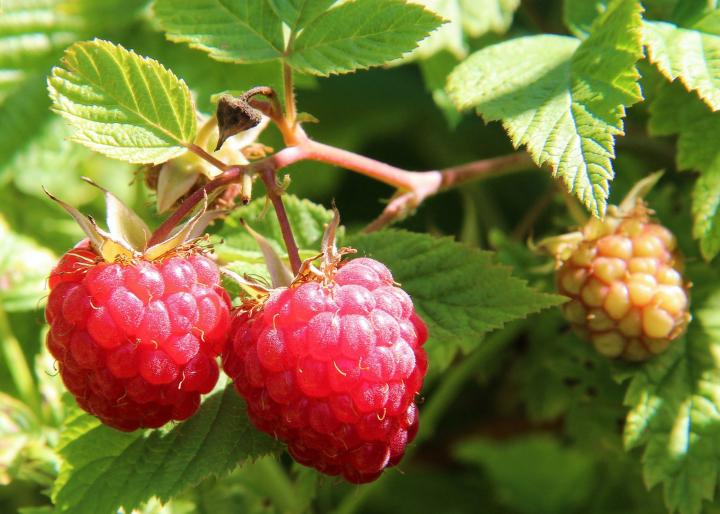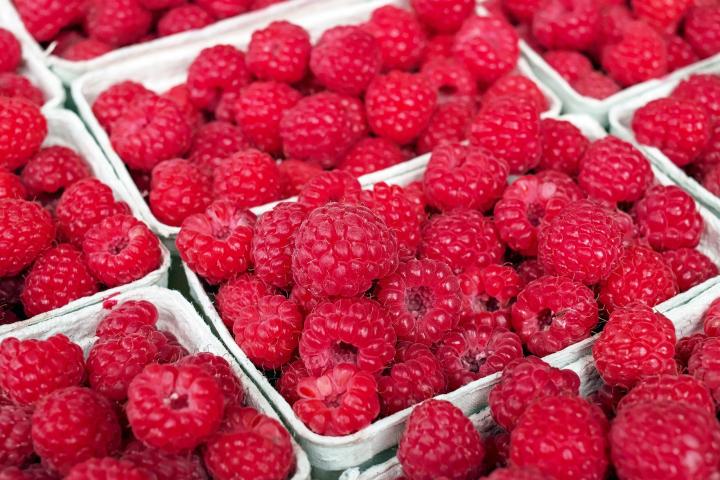
Planting, Growing, and Harvesting Raspberries at Home
Fresh raspberries are wonderful in cereals or paired with a dollop of Greek-style yogurt. Use in smoothies, too!
If the fruit is to be made into preserves, it should be done with fruit that’s as fresh as possible.
ADVERTISEMENT
i planted 15 everbearing type in the spring and they are doing reasonably well. growth has been from 1-3 feet on the plants. even though they will not fruit till next year, should they still be pruned back this winter? thanks
Hi Doug, Thanks for the question. So, it depends on if you want your everbearing raspberry bushes to produce two crops each year (summer and fall) or just one (fall). In order to get that smaller summer crop next year before the bountiful one in the fall, the fruit will grow on the bottom of this year’s canes. If that is the case, leave this year’s growth to see what raspberries will appear early in next year’s growing season. You can then prune those canes out after harvest. If you just want a single fall crop next fall, the fruit will grow on next year’s cane growth, so you can prune out this year’s canes between fall and late winter. Hope this helps!
How long have they been wondering?? :-) "Not only are raspberries perfect for picking and eating straight off the stem, but they’re also wondering in jams, pies and tarts, or smoothies and drinks. "
My raspberries look very healthy with lots of bees and flowers. But the fruit is very poor, misshapen, and not worth picking. Only 1 or 2 little seed pockets. I have used lots of compost as well as water. What is cause and what is cure, this is third year this has happened!
Hi, Anna, We understand your disappointment. There is no easy solution; we found a few trusted cooperative extension services that offer several reasons why your canes may not be fruiting. If none of this applies to your circumstances, you might consult your local cooperative extension or a good plant nursery. Best wishes!
Short plants that fail to thrive and produce poorly can be from several causes [edit note: do not know what is meant by “short plants]:.
· Raspberries perform poorly in heavy soils with poor drainage. They produce best when grown in raised beds in soil you amend before you plant.
Raspberries perform poorly in a xeric environment. When you water them irregularly or inadequately, you might get short plants. Water raspberries an inch of water per week for good production.
· Raspberries will not thrive under crowded conditions. Thin canes to 8 inches apart in spring as early growth starts.
· Raspberries require fertile soil to thrive. Apply a general nitrogen fertilizer.
· Raspberries produce poorly with inadequate light. Plant raspberries in an area with at least 6 hours of direct sun daily if part of the day is shaded, it’s best in late afternoon.
· Spider mite infestation causes yellow spots that turn into bronzed foliage. Mites are more of a problem in hot locations and during hot summers. To control spider mites, provide adequate water and spray the undersides of leaves as needed.
· The raspberry cane borer causes wilted and drooping tops of canes. To prevent the white larvae from tunneling down further into the cane, prune off the cane tops at the earliest sign of the insect. Destroy pruned branches containing the insect. Insecticides such as carbaryl (Sevin®) are registered for this pest.
· Sunscald and heat are the cause for white druplet disorder on the fruit. A few of the druplets or perhaps an entire sun-exposed side of a berry turns white. The rest of the fruit colors normally. This does not harm the edibility of the fruit, just the appearance. It is an environmental disorder and not one caused by a fungus or bacteria so no sprays are needed. Good leaf cover will be helpful so put efforts into adequate watering and fertilizing.
When did you cut back the canes? Only everbearing raspberries are cut back completely in early spring before new growth begins. See following pruning information for early summer bearing raspberries; just in case:
Red or Yellow Raspberries (Summer Fruiting)
Pruning During the Growing Season
Do not pinch back (reduce the height) the current season’s growth. If the canes are too tall to support themselves, it is better to construct a trellis than to reduce the height. Remove floricanes after harvesting the fruit. This is usually in late June through early July, depending on the cultivar and weather. Removing canes allows better light penetration into the hedgerow for the newly developing shoots (primocanes) and will significantly reduce disease problems.
Dormant Season Pruning
Prune in late winter or early spring after the danger of severe weather has passed and before bud swell. Pinch back (remove) the winter-killed portion of the canes. Usually, this will be 1 to 3 inches of the cane tip. However, after severe winters or if you have attempted to grow non-hardy cultivars, 3 to 4 feet of the cane may have been killed. If the plants are grown in hedgerows, keep the width of the rows to 18 inches or less and remove all plants outside the row areas. Remove small spindly canes, leaving those that are one-half inch or more in diameter. Summer red raspberries should be pruned twice a year, first in the spring and immediately after harvest. The spring
pruning, in late March or early April, consists of removing all weak canes. The second pruning, right after harvest removes canes that produced fruits. The new shoots or suckers should be reduced in number (thinned) immediately after fruit harvest. Leave four or five strong canes, one-half inch in diameter or greater, per foot of hedgerow. If no such canes are present, leave the two largest canes per foot of row.












Comments